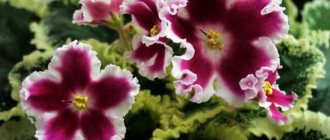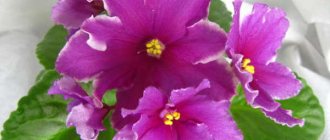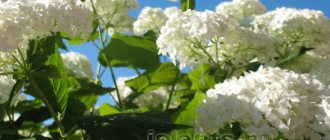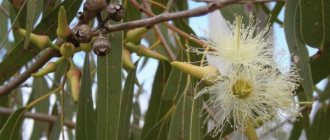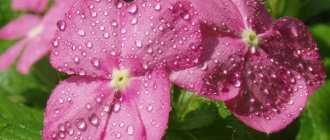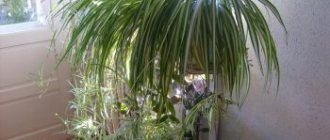Botanical features of the Canary date palm
The Canary Islands are considered the birthplace of the Canary date palm. In their natural environment, the trees grow in the humid forests of South Asia and Africa.
Today, the Canary date, or Luxor, is found in all regions with tropical and subtropical climates.
Under natural conditions, a palm tree grows on average from 15 to 25 m. A date tree grown in a greenhouse or at home will reach a height of 1.5-2 m.
The trunk of the perennial palm is straight, with multiple scars remaining after shedding the leaf blades. The crown is lush, concentrated at the top of the tree.
Each leaf blade contains up to 150 sharp, narrow leaves of silver-green shades. The length of the leaf blade of an adult tree reaches 6 m. In adult trees, long, sharp thorns are formed in the lower part of the leaf cover.
During the flowering period, inflorescences appear on the tree, male, cream-colored, and large female, yellow and orange flowers.
In place of the flowers, small, sweet and fleshy fruits of orange shades are formed, each of which contains a large seed.
Interesting! African tribes still use large palm leaves to cover the roofs of houses to this day.
Types of date palm for indoor culture
Previously, only one species was grown at home:
The palmate date (Phoenix dactylifera) is a true date palm, the type species of the genus, common in the oases of Western Asia, the Arabian Peninsula and the Sahara deserts, as well as on the Canary Islands. The trunk is vertical, often covered with the remains of petioles of dead leaves, and grows up to 15-26 m in height, some up to 30 m.
The leaves are large, up to 6 m long, grouped in a bunch at the crown of the trunk. Flowers are wind pollinated, unisexual, in panicle inflorescences. The fruits are elongated drupes about 8 cm and up to 4 cm wide. They do not lose their taste even at 14 degrees below zero.
Date palmate
Currently, other, more decorative types are used in interior design:
Canary date (P. canariensis) - originally from the Canary Islands, but naturalized throughout the subtropical zone of the planet and now grows from the northern regions of France to the southern Chilean provinces. The tree reaches a height of 10 to 40 m. Date leaves are huge, complex-pinnate, reach 4-6 m in length and consist of 80-100 fragments on both sides of the main axis. The fruits are orange oblong berries with a large seed.
Date canarian
The Robelen date (P. roebelenii) is a popular houseplant native to Laos. It reaches 2-3 m in height, which is why among gardeners it is often called the dwarf date palm. It grows into several trunks, each of which gracefully arches from the center of the bush. The leaves are pinnately divided, grayish-green in color, pubescent below, from 60 to 120 cm long, up to 100 lobes 15-25 cm long and 1 cm wide are formed on one petiole. The flowers are small, sunny yellow, forming inflorescences 45 cm long. The fruits are drupes with a thin layer of pulp.
Date Robelena
Forest date (P. sylvestris) - also known as the silver date palm. It grows in southern Pakistan, India, Sri Lanka, Nepal, Burma and other South Asian countries. It can grow from 4 to 15 m high. The trunk is not thick in circumference - up to 40 cm. Foliage about 3 meters long forms a lush crown with a diameter of up to 10 m and can consist of 100 leaves. Inflorescences of small white flowers droop downwards, then form large inflorescences with purple-red berries, which are used to make jelly and wine. The sap from palm trunks is drunk fresh, made into punch, or boiled to produce jagged sugar.
Advantages and characteristics of the plant
The main advantage of the Canary date palm is its ease of care. With good lighting and timely watering, the tree grows and develops quickly.
The Canary date takes root well and purifies indoor air from the negative effects of the environment.
Exotic crops are grown in winter gardens, greenhouses, greenhouses, loggias and indoors. At home, a well-lit, free space is chosen for the date palm.
Date Canarian: signs and energy for the home
A palm tree in a home is by default considered a source of prosperity and love in the home. As for the Canarian date, the plant is also considered a source of abundance, positive energy and protection from adverse circumstances.
The Canarian date is also perfect for growing in the office: its energy attracts wealth and good luck in making deals. This palm tree should not be placed in the bedroom, because the plant’s too powerful energy will interfere with restful sleep. The ideal placement is in the hall or living room, where the whole family gathers. This strengthens family ties and brings the work team together in the office.
Variety varieties
Luxor, a variety of the Canarian date palm, adapted for indoor cultivation. The tree is distinguished by its compactness; with proper care, it grows from 1.5 to 2 m. The crown is lush, branched, with many large, feathery leaves of bright green shades.
The miniature palm tree is used for landscaping apartments, houses and office premises.
Important! The Luxor palm grows lush and beautiful only under conditions of good sunlight and high humidity.
How to plant and grow a date palm from a seed at home
The date palm is a common indoor plant that is very easy to grow yourself from seeds. And in the subtropics of the Black Sea coast, dates can also grow in a garden plot.
What are date palms and how do they reproduce?
There are several varieties of date palms known in nature, of which two species are of greatest interest for indoor cultivation - Canarian and palmate dates.
Absolutely all date palms are dioecious plants, in which male and female flowers are formed on different trees.
Dates do not bear fruit indoors and are grown solely out of curiosity or for decorative purposes.
True date palm (date palm)
The palmate palm is the same palm tree that produces delicious sweet dates that are sold in stores all year round. Each date contains an elongated pit with pointed tips. Seeds from store-bought dried fruits remain viable and are suitable for sowing.
The fruit of the palmate date is a famous sweet and tasty date.
The palmate date grows in the hot tropical deserts of Africa and Arabia. At the base of old trees, numerous root shoots often form, due to which plant regeneration occurs.
Real date palms grow in tropical deserts
Canarian date palm
The Canary date grows in the wild only in the Canary Islands. It is often grown as an ornamental plant in subtropics around the world, including in Russia along the Black Sea coast. This palm tree does not produce root shoots and reproduces only by seeds.
The Canarian date palm is grown as an ornamental plant in many countries
The fruits are not eaten due to their small size and fibrous pulp. Canary date seeds have an oval shape with rounded tips. You can pick up ripe fruits in December - January in the cities of the Black Sea coast, where these palm trees grow in abundance.
The fruits of the Canarian date are easily identified by the rounder seeds than those of the real date.
In my opinion, the Canarian date is more interesting for home cultivation: its plants have more graceful leaves and a fluffier crown, they look much more attractive than potted palmate date plants at a similar age.
Canarian date plants look very attractive
Indoor conditions are generally not particularly comfortable for a real date palm, accustomed to a hot desert climate.
The palmate date is less decorative, but its seeds are easier to find
How to plant date pits at home
Stones from dried dates bought in a store or freshly collected from a tree are suitable for planting. The planting technology is very simple:
- Remove the seeds from the fruit and rinse thoroughly with water. For fresh ones, a simple wash is enough; pits from dry store-bought dates can be soaked for two days in boiled water at room temperature.
Before sowing, date pits are removed from the fruit.
Date pits are stuck into the ground vertically or laid horizontally with the slit down.
Date palm seedlings at first look like wide blades of grass, and not like an adult palm tree
Date palm shoots do not look at all like adult palm leaves, but look like wide blades of grass with a fold. It will take at least a year before true feathery leaves appear on young plants. If two-year-old palm trees still have intact leaves, this is a sign of insufficient lighting.
Sometimes it is advised to pre-germinate the seeds before planting in wet sawdust or hydrogel on a radiator, but this method has at least two big drawbacks:
- it is very difficult to ensure that the sawdust on the battery never dries out within a month;
- The sprouts are quite fragile, and there is a risk of breaking them off when planting - planting unsprouted seeds in the ground is much easier and more convenient.
Growing a date palm from a seed - video
Replanting indoor date palms and caring for them
Date palms are very sensitive to root damage and do not like transplanting. Until the age of five, they are transplanted once a year in the spring into a slightly larger pot; for older ones, once every three to four years. Pots need to be tall, stable and heavy, with drainage holes and a layer of pebbles at the bottom. When replanting, it is important to keep the earthen ball with roots intact. The soil mixture is prepared from mixed in equal quantities:
- leaf earth,
- turf land,
- river coarse sand.
The soil in the depths of the pot should always remain slightly moist; if the earthen clod dries out, the palm tree dies. In adult plants in large tubs, it is advisable to allow the top two to three centimeters of soil to dry out between waterings to prevent mold from appearing.
In summer, date palms are useful to keep in the fresh air
The optimal temperature for wintering date palms is about +15°C; in summer it is advisable to expose them to fresh air, first in partial shade, then in a brighter place, gradually accustoming them to direct sunlight. Dates tolerate dry air well, but the leaves must be wiped with a cloth to remove dust weekly.
Planting dates in open ground
In the subtropics of the Black Sea coast, the Canary date palm successfully grows and bears fruit in open ground.
On the Black Sea coast, the Canary date grows well in open ground
Residents of the subtropical zone of the Krasnodar Territory and the southern coast of Crimea can plant a young palm tree grown from a seed in the garden, taking care of winter protection for the first ten years after planting . It should be planted in a sunny location with well-drained calcareous soil. It is best to plant young seedlings grown in pots when they are 3–4 years old. When planting, it is important not to damage the fragile roots and maintain the same position of the root collar relative to the soil level. Young palm trees must be watered during drought so that the soil at the roots does not dry out. Adult specimens do without watering.
The Canary date blooms in the fall from the age of five, and if there are male and female plants nearby, it will bear fruit . The fruits ripen by December of the following year after flowering; they are theoretically edible, but fibrous and tasteless.
The fruits of the Canary date are not used for food due to their small size and fibrous pulp.
Adult specimens of the Canarian date palm tolerate short frosts down to -8..-9°C. Young plants need protection from agrofibre or matting for the winter . The most vulnerable spot in a palm tree is the apical growth bud at the base of the leaves; if it is damaged, the plant dies. If only the leaves themselves are damaged, this is not fatal; they can be cut off, then new ones will grow in their place.
The palmate date does not survive in the Black Sea subtropics due to excess humidity.
Reviews
I also just pushed it into the ground. They sprouted quite quickly: in 2–3 weeks. She's probably 3 years old now. And there are still 3 leaves sticking out. But I am patient, so I will wait for the beautiful palm tree.
Inna https://www.flowersweb.info/forum/forum48/topic9709/messages/?PAGEN_1=2
My date palm is 1.5 years old and already has three feathery leaves. It's all about the lighting. This palm tree really loves sunlight.
Sergey https://forum.homecitrus.ru/topic/11311-finikovaia-palma/
It is best to stick it in a pot and forget, but do not allow the soil to dry out. I stuck pots with seeds at intervals of a couple of cm. For the sake of experiment, I sawed some, soaked others, and others just like that. I didn’t notice any difference in germination. About half of those planted have sprouted.
Coffee https://www.flowersweb.info/forum/forum48/topic9709/messages/?PAGEN_1=2
The soil should be moist. The date will not tolerate dry soil. If it dries, it's gone forever.
DonnaRosa https://forum.homecitrus.ru/topic/11311-finikovaia-palma/page-5
Growing a date palm from a seed is quite easy, but you have to wait a long time for the results. It is clear that it will never yield fruit on the windowsill, but there will be an interesting exotic plant in the room, grown with your own hands.
What you will need
Before planting the Canary date palm, stock up on fresh seeds and patience. After all, the period of germination of seeds of an exotic tree will take from 2 to 4 months.
See also
Description and propagation of Chinese dates, planting and caring for the tree
Read
Container and drainage
Palm rhizomes develop in depth, so deep and tall pots are chosen for planting.
At the bottom of the container in which Luxor is planned to be planted, lay a thick drainage layer of small stone, crushed stone or pebbles.
Stagnation of water in the pot will lead to rotting of the root system and death of the tree.
Required soil composition
Soil for planting date seeds can be purchased from flower shops or prepared independently.
To do this, mix peat, compost, light, turf soil, charcoal and sand. A little organic matter is added to the finished mixture.
If it is not possible to prepare the soil yourself, buy universal soil for growing flowers in the store.
How to germinate a seed
A shoot from the seed will grow only if the fruit has not been heat treated. To try to grow a palm tree from a seed, you can use both seeds from fresh fruits and dried fruits purchased in a store, if they were dried naturally.
Soil for the plant
You can germinate the seed in ordinary soil or soil used for home flowers, but it is better to prepare a special nutrient mixture that will help speed up the growth of seedlings. To do this, you need to mix the soil with sawdust in a 1:1 ratio.
You can prepare another option, which is suitable not only for germinating seeds, but also for maintaining an adult palm tree. For it, you need to mix an equal amount of clay-turf soil, humus with leaf soil, peat and sand. You need to add a large pinch of charcoal to the resulting composition and mix the soil well so that the mass becomes homogeneous.
Preparing for germination
Before planting in the ground, seeds need to be prepared to increase their germination. To get one palm tree, it is better to take about 5-8 seeds at once, since some of them may not sprout or die as they grow. They should be freed from pulp, rinsed well and left to dry completely. After this, the planting material must be soaked in warm water for several days and left in a place with good heating. With this method of germination, water should be changed daily.
There is another way to prepare the seeds for planting. It is necessary to make 1-2 punctures on each seed with a sharp object so that water can get inside. After this, the bones need to be wrapped in several layers of soft cotton fabric or cotton wool. Planting material should be placed in a container with a small amount of water and left for 3-4 days in a warm place. It is necessary to ensure that the seeds have constant access to liquid, adding it as it evaporates. When the seeds swell a little, they can be planted.
Planting and watering
It is recommended to plant seeds in the ground in winter, since at this stage the plant will not need as much light as in subsequent periods of development. To germinate dates from seeds at home, you must proceed according to the following scheme:
- Soil is placed in a common pot for all seeds, which is watered moderately with water until moist.
- Prepared planting material is planted at a distance of at least 5 cm from each other. Seeds should be planted in the ground to a depth of 1.5 times their length.
- Immediately after planting, watering is not carried out.
- The pot with the future palm tree should be placed in a warm place with a temperature of about +30 degrees. For additional insulation, small greenhouses can be built above each bone by placing plastic glasses upside down. Remember, dates do not tolerate temperature changes; they must always be warm.
- To obtain seedlings, you need not only high temperature, but also sufficient soil moisture, so future palm trees should be watered every day without flooding them. Instead of watering the soil, you can irrigate it using a sprayer.
Seedling of seedlings
If you managed to germinate more than 1 seed, the seedlings will have to be planted in different pots. You can begin this procedure after the plants have grown at least 10-15 cm in height. If you do not do this, the dates will become crowded and they will die.
How to properly transplant violets at home
For the future palm tree, you need a high pot in which the long roots of the plant, with a diameter of at least 12 cm, will be placed. Special soil is poured into the container, which should be moistened. In order for the palm tree to grow comfortably, you need to put a good layer of drainage on the bottom of the pot. Pebbles, expanded clay or any bulk materials are suitable for this purpose.
Selecting and preparing seeds for planting
The main condition when choosing planting material is that the palm seeds are not subjected to heat treatment.
The seeds can simply be planted in fertile soil and wait 5-6 months for the first shoots to appear. But to speed up the process of germinating date seeds, you will have to do the following:
- Date pits are thoroughly cleaned and washed, then dried.
- Before soaking, the seeds are scalded with boiling water or small cuts are made on them. Such measures will allow moisture to quickly get inside the planting seed.
- To soak a date pit, you will need any natural fabric or cotton wool.
- The seeds are wrapped in material and thoroughly moistened.
- The container with the seeds wrapped in a wet cloth is placed in a warm place.
- Until the bone swells, constant hydration is maintained.
- As soon as the seeds have increased in volume, they are transplanted into fertile soil.
Important! For germination, prepare a few date pits. After all, plants tend to get sick and die if transplants are unsuccessful, so in order to grow a healthy and beautiful tree, it is better to play it safe.
How to grow a date palm from a seed: planting and care at home
The desire to have a date palm at home often arises in people after vacationing in exotic countries. The implementation of this idea is possible if you plant a date. As a beautiful tropical plant, this crop has long been readily grown in homes. However, it is worth knowing that not every type of this palm tree is suitable for growing at home, and caring for it can cause a lot of trouble. Let's look at how to grow a date palm from a seed, how to care for it, and also discuss what diseases can threaten the plant.
Origin
The plant is native to Iraq and is currently grown in North Africa, the Middle East and the United States. It was already cultivated in ancient times, as evidenced by date seeds found in Israel and dating back to the 1st millennium BC.
Description
The date palm from the Canary Islands is most often grown as a potted plant due to its better adaptability to indoor conditions. It is a slow growing plant that forms a long stem. At the very top of the trunk, arched stems appear, consisting of many lanceolate leaves. One leaf can reach five meters in length, and the palm itself reaches 30 meters in height. The leaves have a very variable shape - some are stiff and raised, others are curved and flaccid. The spadix-shaped inflorescence appears only in older plants and only in nature.
Types for growing indoors
At home, three types of date palms are most often grown (in a pot). The first of these is the Canary palm (Phoenix canariensis), which is native to the Canary Islands. The leaves of this plant are bright green and can reach 5 meters in natural conditions. This species grows more slowly than other members of the genus and has a thicker trunk. This is the most resistant species to adverse conditions, best suited for growing at home.
The date palm (Phoenix dactylifera) grows much stronger and faster than other species. In its natural environment it reaches 20 m in height. In southern Africa, southwest Asia and Spain it is grown as a fruit tree that produces excellent fruit.
The Robelin date (P. roebelinii) is a species originating from India. Without a doubt, the most beautiful date palm. It has very dense and more beautiful foliage. However, it is a little more difficult to grow - the crop is mainly suitable for greenhouses. Still, many people grow this species in apartments because it reaches smaller sizes and is easier to find a place in the house.
Date palm from seed
The plant can only be propagated using its seeds. This is a fairly simple process, but it will take a lot of time to get the desired result. If the correct microclimate is created, palm tree seedlings can be obtained from date kernels within a period of two to six months.
The first step is to buy fresh dates and remove the pits. It is better to use the seeds immediately after eating the fruit (no later than 2 days), because later they lose the ability to germinate.
Many people, eating fruits such as dates, have probably thought about how to germinate a date pit. To do this, the seeds should be soaked in warm water for two days. Next, you need to prepare a container with a mixture of palm soil and sand in a 1:1 ratio. The seeds should be placed in the substrate to a depth of 1 cm and watered. Then cover the container with a plastic bag and secure it with an elastic band. This creates the desired microclimate for seed germination. From the moment of sowing and until the sprout of the young plant reaches approximately 4 cm in height, the bag must not be removed from the container. After this time, you need to start hardening the seedlings, removing the bag every day (for seven days) for about four hours a day. The seedling prepared in this way is planted in a pot filled with humus or soil specially designed for palm trees. In the first year of cultivation, a small but deep and narrow pot will be most suitable. For the first three years, the plant will need to be replanted every year.
Location and temperature
The date palm should be located in a sunny place in summer, but protected from direct wind (this is important when the plant is placed outside). If the plant is kept indoors all year round, then during the growing season it should stand in a bright place, but not directly in the sun. It is best to place the pot with it at a distance of 0.5-2 meters from the window. In winter, young seedlings should be moved to a bright room where the minimum temperature will be +8 ºC, although older plants can withstand even +4 ºC. An exception is the Robelena date, which must be kept in a room with a temperature of at least +16 ºC throughout the year.
How to water a date palm?
Palm trees are watered intensively only in summer. The lack of water should only be replenished when the soil in the pot dries out. The plant reacts very poorly to excessive watering. It is necessary to place a drainage layer on the bottom of the pot so that excess water drains out well. This can be a layer of gravel 3 cm thick or small pebbles. It is also advisable to fill the stand for the pot with expanded clay or small pebbles so that the pot stands on pebbles and not in water. To water dates, use warm water, pH 5-6; too hard water can lead to darkening of the leaves.
In addition, date palm grown from seed requires high indoor humidity. She likes frequent spraying of the leaves, so this procedure should be done at least three times a week.
Fertilizer
Young date palms grown from seed are fed only after the first six months of life. It is not recommended to plant seedlings in soil with granular fertilizer already added.
From March to July, feed the plant every week with liquid multi-component fertilizer (fertilizer for palm trees is best). It is added to water and the plant is watered with this mixture.
Transfer
Young seedlings must be replanted every year. Adult plants - only as needed (every two or three years), until the diameter of the pot reaches 50 cm. The soil for the date palm should have a lot of humus. You can use palm soil (from the store) mixed with burnt sand and clay in a ratio of 6:3:1. The soil pH should be between 5.7 and 6.8.
Pests
Pests of potted plants can affect dates grown indoors. The main reason for their appearance is too high a temperature and low air humidity, and therefore their re-invasion can be prevented by improving the growing conditions of plants.
The indoor date can often be attacked by spider mites, small insects with eight legs, no more than 1 mm long and a yellow-green or red-orange body. Its presence appears as yellowish-white spots on the leaves. The spots cover an increasing area of the leaf over time, causing it to dry out and fall off. It may also happen that the leaves will be covered with a thin web. The development of these pests is favored by high temperatures and dry air. When growing dates in an apartment, the fight against spider mites will be easiest thanks to the use of preparations sold in ready-to-use form in a small container with a spray bottle. You can use the natural product Agricolle Spray or a product with chemicals - Polysect Ultra Hobby AL. Spraying should be repeated after 7 days. However, before you look for products in the store, you should try home methods to get rid of spider mites, such as spraying with a solution of gray soap and denatured alcohol (20 g of soap and 10 ml of denatured alcohol in 1 liter of water). With a small pest infestation, the use of such a product should help.
A common pest of potted dates is aphids - winged or wingless insects with a body length of up to 5 mm. They can be found in abundance on shoots and the undersides of leaves, from which they suck juices. Aphids are especially dangerous because they often transmit viral diseases. Leaves and shoots of affected plants may be misshapen, sticky, and blistered. A small number of pests can be controlled by washing the plant with water. When controlling pests with chemicals, you should choose a product that can be used indoors. As with spider mites, you can use the natural product Agricolle Spray.
Diseases
Unfavorable growing conditions cause date palm diseases, most often leaf diseases. Lack of fresh air often leads to bacterial or fungal infections. For this reason, it is worth placing date palms on your balcony, terrace or garden. Lack of light causes yellow spots to appear on the leaves. However, the darkening of their ends can be caused by various reasons:
- soil salinization due to watering the plant with too hard water and applying too high doses of fertilizers;
- excessive watering (especially in winter);
- lack of water in the roots of the plant when releasing new shoots,
- The air in the apartment is too dry.
The brownish tip of the leaves needs to be cut off. This should leave a narrow strip of dead tissue. If whole leaves are being removed, a sharp knife should be used to ensure the cut area is as smooth as possible.
Is it possible to get the fruits?
Under natural conditions, date palms can bear fruit after four or six years of cultivation, but at home - only 12 or more years after seed germination. Potted dates, although they are extremely ornamental plants, grow rather slowly and practically do not bloom at home, which means they do not bear fruit.
The Canary date is most often recommended for growing at home. A large and beautiful plant can be obtained if you properly care for your date palm.
The Robelena date can be characterized as a more capricious potted plant. It should only be grown in greenhouse conditions or in greenhouses, because it does not live as long in apartments and requires more careful care.
Now you know how to plant a date and grow a beautiful exotic plant at home. We hope everything works out for you.
Step-by-step algorithm for planting a seed
The process of planting prepared date seeds is simple and does not take much time.
- Fertile soil is poured into the prepared pot.
- The soaked seeds are placed in the soil in a vertical position at a level of 1 to 1.5 cm from the soil surface.
- The seeds are sprinkled with a layer of soil and watered.
- Pots of dates are sent to a warm, well-ventilated and humidified room, and covered with film. Remove the film after the first shoots appear.
- As the tree germinates, it pushes the bone shell to the surface of the soil, exposing the roots. Do not allow the shoot to become exposed; periodically add fertile soil.
- The first above-ground shoots appear after 1.5-2 months. Young plants are planted in separate containers.
Advice! It is best to germinate date palm seeds in early spring. In this case, during the summer period the shoots will take root and take root, and will receive a sufficient amount of sunlight and heat.
Growing Canary date from seeds
Canarian date seeds photo
The plant is propagated by seeds. They are purchased at special sales points. If you have a date fruit that cannot be cooked, the seed can be used for planting.
Place the date in warm water until the pulp is well separated (it must be completely removed, otherwise mold will form after sowing). Plant one seed at a time in small pots (0.3-0.5 l volume) with moist palm substrate, placing them vertically. Water minimally, avoiding over-watering; a sprout will appear in 2-3 weeks, sometimes in a week. Do not allow the substrate temperature to drop below 21°C.
Sprouted Canarian date seeds photo
It is advisable to germinate seeds from dry date fruits in vermiculite. Soak overnight to remove any pulp that has turned into a tough skin. Take a plastic container with a tight lid, add damp vermiculite, place the seeds and cover. Place in a warm place, add water (literally a couple of spoons at a time) so that the substrate does not dry out.
An excellent way to germinate seeds in a substrate with bottom heating:
How to germinate date palm seeds photo
The seeds will hatch after 14 days; it is important not to miss this moment so as not to break off the sprout when planting. When sprouts appear, transfer the seeds very carefully into pots and sprinkle with soil 2-3 cm.
Canarian date shoots photo
As it grows, a juvenile leaf will first appear, which will develop into a “arrow” with 2-3 leaves. Provide diffuse lighting, warmth and high humidity, and water minimally. Keep an eye on the drainage hole - the root should not penetrate through it before transplanting into a larger pot. It is important not to damage the root during handling (at first it forms a single and long one).
Canarian date from seeds photo of seedlings
A month after transferring the Canary date into a permanent pot, you can feed it with half a dose of complex mineral fertilizer.
Necessary conditions for crop germination
To germinate date palm kernels at home, it is important to observe the temperature regime and maintain the humidity necessary for the plant.
Placement and lighting
The Canary date palm will grow beautiful and healthy only if there is good lighting. Pots with seeds are placed on window sills in the southern part of the premises.
Luxor, an exotic crop, therefore requires sunshine all year round. In winter, the tree is additionally illuminated, and the pot with the plant is evenly rotated so that each side of the plant receives the same amount of lighting.
Optimal temperature conditions
When air humidity is low, the Canary date begins to ache. The leaves of the tree dry out and fall off. The tree and the room are additionally sprayed with water, creating conditions comfortable for growth and development.
When germinating seeds, it is also important to observe the temperature regime. In the room where the pots with seeds are located, the temperature is maintained at least +22 degrees. If the temperature rises, the room is additionally humidified.
Ventilation
In the process of growth and development, Luxor requires an influx of fresh air. Until the seeds germinate, remove the film daily and ventilate the pots with the planted plants.
See also
The benefits and harms of kiwi for the body, how to eat the fruit and contraindications
Read
In the summer, an adult palm tree is taken out to the garden plot; in the winter, the room where the pot with the tree is located is ventilated.
Important! When ventilating the room, do not allow too sharp a change in temperature.
Date palm. Growing problems:
- Plant growth stops at low temperatures. Root activity stops at a temperature of 16-17 ºC.
- The tips of the leaves dry out in conditions of too dry air, sudden temperature changes, and cold drafts.
- Yellowing of the date palm occurs when the soil is excessively waterlogged or watered with hard water. If this happens in winter, this may indicate a high temperature for the winter period.
- Foliage withers due to insufficient watering.
- Yellowing of the foliage indicates a lack of moisture and nutrients, and sometimes watering with hard water.
- Brown leaves and a soft trunk of the plant indicate overwatering; it is necessary to stop watering and dry the soil. It is also advisable to check the root system of the palm tree; if the roots of the plant have become soft or watery, they must be removed and the whole roots sprinkled with crushed coal.
- Fading foliage indicates too much light or spider mites. In the first case, shading the plant will help. In the second case, treatment with a soap solution is necessary.
Views: 1,562
How to care for a sprout
The Canary date palm is an unpretentious crop. It is enough to follow the rules of care, which include watering, maintaining air humidity and timely feeding of the exotic plant.
Watering
Young shoots require frequent and thorough watering. Irrigation measures are carried out as soon as the top layer of soil dries out.
Date seedlings react negatively to waterlogged soil. Stagnation of water in the pot causes softening and loss of color in the leaf plates. Lack of watering is also not tolerated by shoots. Green leaves droop and do not recover.
Water the tree with warm, settled water. In winter, irrigation activities are reduced.
Fertilizer application
Additional nutrition is important for a developing plant. Mineral and organic fertilizers are alternately used as fertilizers.
In spring and summer, seedlings are fed once every 10-12 days. In winter, fertilizing is reduced to 1 time per month.
Leaf trimming
The formation of the date palm crown occurs during the process of plant growth and development. First of all, cut off broken, dry and dead leaves.
Trim the leaves carefully without damaging the trunk and roots of the plant.
In winter, dried, yellowed leaves often form on the date tree. It is not worth pruning them, because the root system uses the dying leaf plates as additional nutrition, sucking out the last juices from them.
Transfer
During the first 3 years of growth, Luxor is replanted annually. The exotic crop develops roots quickly, so the pots for the tree become small.
Containers for transplantation are selected twice as large as the previous one. To replant young trees, the soil is completely changed. And for large palm trees, only the top layer of soil is replaced once every 3-4 years.
Important! Transplantation is carried out carefully, avoiding damage to the roots of the plant. Luxor has difficulty with the transplant procedure and often gets sick after moving to a new place of residence.
Replanting indoor date palms and caring for them
Date palms are very sensitive to root damage and do not like transplanting. Until the age of five, they are transplanted once a year in the spring into a slightly larger pot; for older ones, once every three to four years. Pots need to be tall, stable and heavy, with drainage holes and a layer of pebbles at the bottom. When replanting, it is important to keep the earthen ball with roots intact. The soil mixture is prepared from mixed in equal quantities:
- leaf earth,
- turf land,
- river coarse sand.
The soil in the depths of the pot should always remain slightly moist; if the earthen clod dries out, the palm tree dies. In adult plants in large tubs, it is advisable to allow the top two to three centimeters of soil to dry out between waterings to prevent mold from appearing.
In summer, date palms are useful to keep in the fresh air
The optimal temperature for wintering date palms is about +15°C; in summer it is advisable to expose them to fresh air, first in partial shade, then in a brighter place, gradually accustoming them to direct sunlight. Dates tolerate dry air well, but the leaves must be wiped with a cloth to remove dust weekly.
Possible problems and their solutions
Canary date palm grown at home is not susceptible to multiple infections by fungal and viral diseases. Also, the plant is rarely affected by pests. But if the appearance of the tree has changed dramatically, and the leaves turn yellow or darken, then it’s time to take urgent measures to save the exotic plant.
Pests and diseases: prevention and treatment
If the rules of care are violated and the air humidity is low, pests appear on the trees. To avoid infection, the trees are carefully inspected, and if uninvited guests are detected, the palm leaves are washed with running water and treated with professional preparations.
Leaves turn yellow and darken
If several leaves on a palm tree have turned yellow, this is the first sign that they are dying. For a plant, this condition is considered normal. But when most of the leaf blades turn yellow, this means that the tree does not have enough sunlight and moisture.
Dark, dry tips of foliage warn of a lack of humidity in the air. In this case, the palm tree and the room are sprayed with water. Large dark spots on leaf blades may appear due to excess moisture or too low room temperature.
Diseases and pests
No diseases, as such, were detected when growing the Canary date.
Difficulties arise from improper care:
- The tips of the Canary date leaves dry out due to low air humidity in the room. Increase humidity by all available means;
- Small white spots have appeared on the leaves - these may be signs of frostbite (the leaves came into contact with a cold window sill or were damaged during transportation; cold air from the air conditioner can cause damage);
- The leaves are covered with brown spots - this happens both when the soil is dry or waterlogged. Adjust watering in the desired direction;
- The lower leaves turn yellow for natural reasons (they die). The reason for the yellowing of the upper leaves or the entire crown lies in the lack of light or drying out of the earthen clod;
- Young, unopened leaves dry out - normally the surface of the leaves is covered with gray-silver scales, so unopened leaves may appear dry. When they unfold slightly, the green part will become visible, but if the shade is yellow-brown, the plant is experiencing a lack of moisture.
Among the pests, the Canarian date can be “attacked” by spider mites, mealybugs and scale insects.
Spider mites are small, reddish in color, and the pest's secretions look like small cobwebs. The leaves will begin to turn yellow and you may notice small black spots.
Mealybugs are white worms that leave a discharge comparable to lumps of cotton wool, the leaves will be curled.
Scale insects are insects with brown shells; they can form round dark growths on leaves and petioles.
First, dampen a sponge or soft cloth with soapy water and wipe the leaves. If this does not help get rid of the pests, use acaricides against spider mites, and insecticidal preparations against the rest. Pests can “migrate” from neighboring recently acquired plants, so “new recruits” must be quarantined and their appearance monitored. Dry air in the room, lack of ventilation, insufficient lighting is a favorable environment for the development of harmful insects, provide proper conditions for the palm tree.
Possible difficulties
- Leaves drooping down are a signal of the need for watering.
- Dry leaves or tips indicate insufficient room humidity.
- Leaves wither and darken when exposed to low temperatures and drafts.
- Stunting of growth may be due to a lack of microelements necessary for the plant.
to contents
Canary date (Phoenix canariensis)
For 8 thousand years, date palms have been cultivated by mankind.
The genus includes 17 species. In turn, each species is represented by both male and female plants.
Date palms are found in Africa and the Middle East, as well as in India and the Philippines.
Date palms grow in areas that are rich in groundwater.
The dates we buy in stores are the fruits of the palmate date (Phoenix dactylifera). The palmate date has long been grown by people in the open air. This date palm is also figuratively called “Bedouin bread.”
The palmate date can also be grown indoors, but more often other species of this genus are grown in homes and offices.
A popular palm species is the Canary date (Phoenix canariensis). From the name it is clear that the birthplace of this date palm is the Canary Islands. The young Canary date has almost no distinct trunk. In nature, the height of the Canary date reaches 10-15 meters. The date is a fast-growing palm tree that has a columnar trunk and numerous feathery leaves ranging from 3 to 5 meters in length.
The Canarian date at home can grow up to 2.5-3 meters in height. To limit the too rapid growth of this palm tree, it should be replanted only when the roots no longer fit in the pot and begin to emerge.
At home, the date palm does not bloom.
In addition to the Canarian date, the Robelin date (Phoenix robelinii) is also grown in the rooms and halls. This is a low date palm. This indoor plant has one or more trunks with beautifully curved feathery leaves reaching a length of 50 cm.
Another well-known “domestic” species is the Theophrastus date (Phoeni[theophrastii). This species is common on the island of Crete.
Robelen date (Phoenix roebelenii)
Date palm (Date). Care at home.
The temperature for growing dates should be in the range of 12-28°C. On hot summer days, it is recommended to ventilate the room in which the date palm is kept. Temperatures can be high in summer. In winter, it is desirable that the temperature fluctuates between 12-16°C.
The lighting is bright and sunny. The date palm needs a lot of light and tolerates direct sunlight well. It is best to place a tub with a date palm near a south or south-east window. In order for the crown to develop evenly, the indoor plant is turned with different sides to the light.
Watering the date palm should be regular. In spring and summer, water the date abundantly, but avoiding excess water in the pot. In winter, the plant is watered moderately. During this period, the soil in the tub should be slightly damp. In addition, it is useful to spray date palm leaves with warm, soft, settled water; In winter, the date palm is also sprayed, but less often.
The soil for date palms is neutral or slightly acidic. You can take a mixture of turf soil, humus, peat and sand in a ratio of 2:2:2:1. You can use ready-made soil specifically designed for palm trees. The top layer of soil must be replaced annually with fresh one.
Dates are fertilized once or twice a month in spring and summer. In autumn and winter, you don’t have to fertilize the date palm.
Date palm replanting should be done as rarely as possible, since the plant does not tolerate replanting well. It is recommended to replant the palm tree no more than once every 4 years, but only if the pot has become too small for the indoor plant. For overgrown date palms, you can use a “heavier” soil, that is, with more of the turf soil.
Date propagation. The date palm (date) can be grown from a seed. The date pit is soaked for 2-3 days in water at a temperature of 30-35 degrees. After this, the seed is planted in a pot of soil. Date seeds germinate quite quickly.
Date palms do not bloom at home.
Palm date (Phoenix dactylifera)


